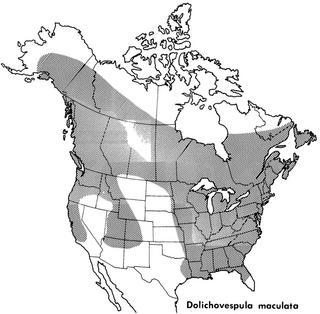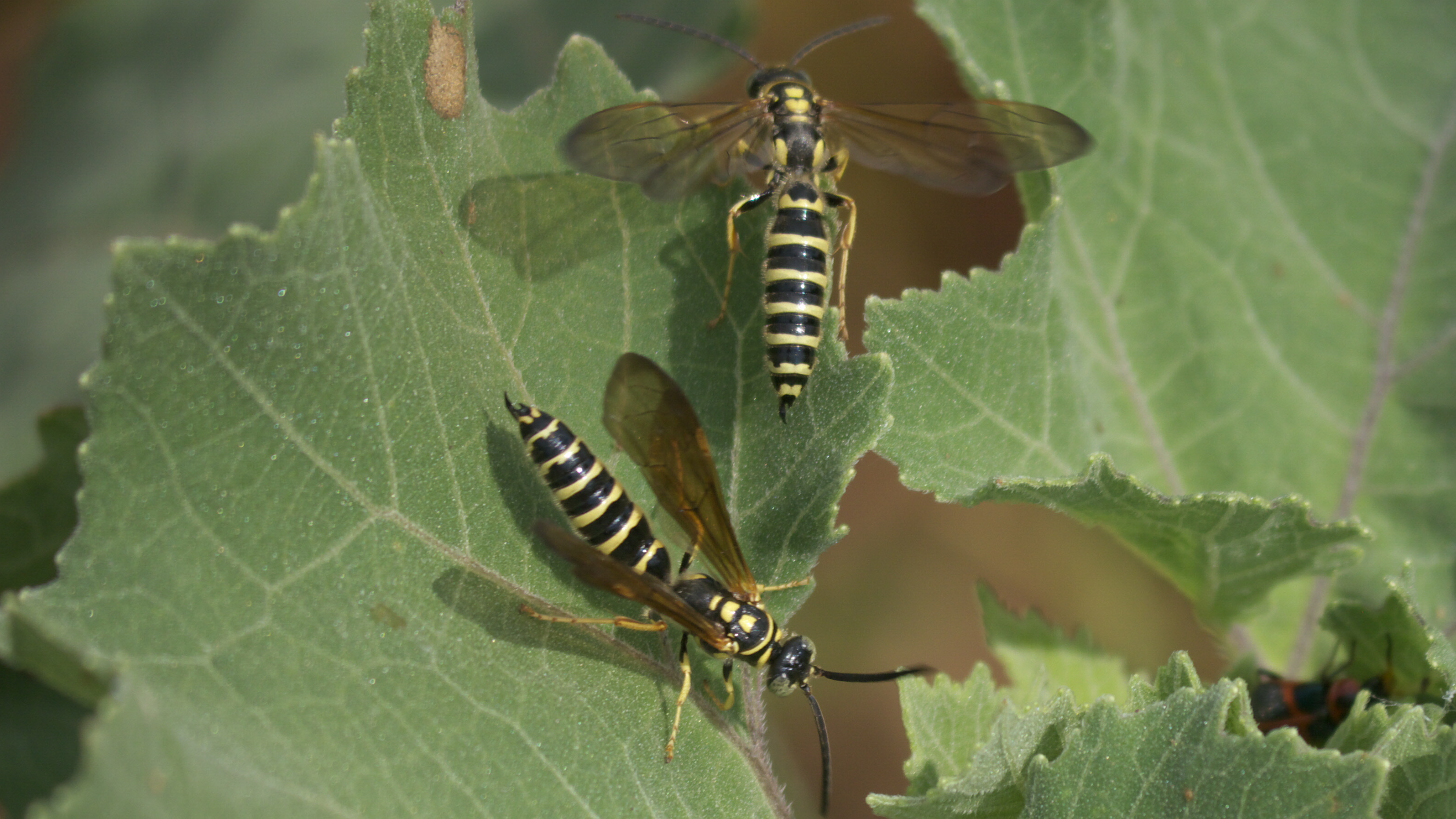|
Vespoidea
Vespoidea is a superfamily of wasps in the order Hymenoptera, although older taxonomic schemes may vary in this categorization, particularly in whether to recognize the superfamilies Scolioidea (for scoliid wasps) or Formicoidea (for ants). Vespoidea includes wasps with a large variety of lifestyles: eusocial, social, and solitary habits, predators, scavengers, parasitoids, and some herbivores. Description Vespoid wasp females have antennae with 10 flagellomeres, while males have 11 flagellomeres. The edge of the pronotum reaches or passes the tegula. Many species display some level of sexual dimorphism. Most species have fully developed wings, but some have reduced or absent wings in one or both sexes. As in other Aculeata, only the females are ever capable of stinging. Phylogenetics and taxonomy Research based on four nuclear genes (elongation factor-1α F2 copy, long-wavelength rhodopsin, wingless and the D2–D3 regions of 28S ribosomal RNA—2700 bp in total) su ... [...More Info...] [...Related Items...] OR: [Wikipedia] [Google] [Baidu] |
Bald-faced Hornet
''Dolichovespula maculata'' is a species of wasp in the genus '' Dolichovespula'' and a member of the eusocial, cosmopolitan family Vespidae. It is known by many colloquial names, primarily bald-faced hornet, but also including bald-faced aerial yellowjacket, bald-faced wasp, bald hornet, white-faced hornet, blackjacket, white-tailed hornet, spruce wasp, and bull wasp. Technically a species of yellowjacket wasp, it is not one of the true hornets, which are in the genus ''Vespa''. Colonies contain 400 to 700 workers, the largest recorded colony size in its genus, '' Dolichovespula''. It builds a characteristic large hanging paper nest up to in length. Workers aggressively defend their nest by repeatedly stinging invaders. The bald-faced hornet is distributed throughout the United States and southern Canada, but is most common in the Southeastern United States. Males in this species are haploid and females are diploid. Worker females can, therefore, lay eggs that develop into ... [...More Info...] [...Related Items...] OR: [Wikipedia] [Google] [Baidu] |
Sister Group
In phylogenetics, a sister group or sister taxon, also called an adelphotaxon, comprises the closest relative(s) of another given unit in an evolutionary tree. Definition The expression is most easily illustrated by a cladogram: Taxon A and taxon B are sister groups to each other. Taxa A and B, together with any other extant or extinct descendants of their most recent common ancestor (MRCA), form a monophyletic group, the clade AB. Clade AB and taxon C are also sister groups. Taxa A, B, and C, together with all other descendants of their MRCA form the clade ABC. The whole clade ABC is itself a subtree of a larger tree which offers yet more sister group relationships, both among the leaves and among larger, more deeply rooted clades. The tree structure shown connects through its root to the rest of the universal tree of life. In cladistic standards, taxa A, B, and C may represent specimens, species, genera, or any other taxonomic units. If A and B are at the same ta ... [...More Info...] [...Related Items...] OR: [Wikipedia] [Google] [Baidu] |
Incertae Sedis
' () or ''problematica'' is a term used for a taxonomic group where its broader relationships are unknown or undefined. Alternatively, such groups are frequently referred to as "enigmatic taxa". In the system of open nomenclature, uncertainty at specific taxonomic levels is indicated by ' (of uncertain family), ' (of uncertain suborder), ' (of uncertain order) and similar terms. Examples *The fossil plant '' Paradinandra suecica'' could not be assigned to any family, but was placed ''incertae sedis'' within the order Ericales when described in 2001. * The fossil '' Gluteus minimus'', described in 1975, could not be assigned to any known animal phylum. The genus is therefore ''incertae sedis'' within the kingdom Animalia. * While it was unclear to which order the New World vultures (family Cathartidae) should be assigned, they were placed in Aves ''incertae sedis''. It was later agreed to place them in a separate order, Cathartiformes. * Bocage's longbill, ''Motacilla boc ... [...More Info...] [...Related Items...] OR: [Wikipedia] [Google] [Baidu] |
Sphecomyrminae
Sphecomyrminae is an extinct subfamily of ants in family Formicidae known from a series of Cretaceous fossils found in North America, Europe, and Asia. Sphecomyrminae contains eight genera, divided into two tribes Sphecomyrmini and Zigrasimeciini. The tribe Sphecomyrmini contains the six genera '' Armania'', '' Cretomyrma'', '' Gerontoformica'', '' Orapia'', '' Pseudarmania'' and '' Sphecomyrma''; while Zigrasimeciini contains '' Boltonimecia'' and '' Zigrasimecia''. A number of taxa have been removed from the subfamily and placed either in other subfamilies or are now treated as ''incertae sedis'' in Formicidae. Sphecomyrminae is the most basal of the Formicidae subfamilies, but has not been included in several phylogenetic studies of the family. Symplesiomorphies of the subfamily include the structure of the antenna, which has a short basal segment and a flexible group of segments below the antenna tip. The petiole is low and rounded, with an unrestricted gaster and the pre ... [...More Info...] [...Related Items...] OR: [Wikipedia] [Google] [Baidu] |
Armaniidae
Armaniidae was a name formerly given to a group of extinct ant-like hymenopterans known from a series of Cretaceous fossils found in Asia and Africa. Armaniidae has been suggested by several authors to belong to the family Formicidae as one of the stem-group subfamilies, Armaniinae; however, this position has not been taken up by myrmecologists. The family contained seven described genera and thirteen described species. An analysis of fossil ants based on antenna structure in 2017 resulted in three of the family being broken up with some genera being moved to Sphecomyrminae and other genera being relegated to ''incertae sedis'' in Formicidae or Aculeata. History and classification Armaniidae was sometimes treated as the most basal of the Formicidae subfamilies, and classed as a stem-group which is more distant in relation to modern ants than the next stem group, Sphecomyrminae. More often the group, treated as "ant-like wasps", was elevated to the rank of family, and considere ... [...More Info...] [...Related Items...] OR: [Wikipedia] [Google] [Baidu] |
Paraphyletic
In taxonomy (general), taxonomy, a group is paraphyletic if it consists of the group's most recent common ancestor, last common ancestor and most of its descendants, excluding a few Monophyly, monophyletic subgroups. The group is said to be paraphyletic ''with respect to'' the excluded subgroups. In contrast, a monophyletic group (a clade) includes a common ancestor and ''all'' of its descendants. The terms are commonly used in phylogenetics (a subfield of biology) and in the tree model of historical linguistics. Paraphyletic groups are identified by a combination of Synapomorphy and apomorphy, synapomorphies and symplesiomorphy, symplesiomorphies. If many subgroups are missing from the named group, it is said to be polyparaphyletic. The term was coined by Willi Hennig to apply to well-known taxa like Reptilia (reptiles) which, as commonly named and traditionally defined, is paraphyletic with respect to mammals and birds. Reptilia contains the last common ancestor of reptiles a ... [...More Info...] [...Related Items...] OR: [Wikipedia] [Google] [Baidu] |
Vespidae
The Vespidae are a large (nearly 5000 species), diverse, cosmopolitan family of wasps, including nearly all the known eusocial wasps (such as ''Polistes fuscatus'', '' Vespa orientalis'', and '' Vespula germanica'') and many solitary wasps. Each social wasp colony includes a queen and a number of female workers with varying degrees of sterility relative to the queen. In temperate social species, colonies usually last only one year, dying at the onset of winter. New queens and males (drones) are produced towards the end of the summer, and after mating, the queens hibernate over winter in cracks or other sheltered locations. The nests of most species are constructed out of mud, but polistines and vespines use plant fibers, chewed to form a sort of paper (also true of some stenogastrines). Many species are pollen vectors contributing to the pollination of several plants, being potential or even effective pollinators, while others are notable predators of pest insect species. The ... [...More Info...] [...Related Items...] OR: [Wikipedia] [Google] [Baidu] |
Rhopalosomatidae
Rhopalosomatidae is a family of Hymenoptera containing about 68 extant species in four genera that are found worldwide. Three fossil genera are known. The adults resemble ants and may be confused with them. They are yellowish with red or brown markings, but may be all brown in colour. Winged species are usually nocturnal, while wingless or reduced-wing species are mainly diurnal. They are solitary, and the larvae are ectoparasitic on orthopteran nymphs. Adults have the tips of two or more antennal segments with spines. The hindwing (when present) has distinct claval and jugal lobes. The metatibia has a calcar or curved spur. ''Rhopalosoma'' is a New World genus (17 spp.) with most species from Central and South America. ''Olixon'' (26 spp.) is distributed through Africa and Australia and the New World. ''Paniscomima'' (11 spp.) is known from India, Madagascar, Africa, and Southeast Asia. Most species of ''Liosphex'' (14 spp.) are found from the southern US to Central and South A ... [...More Info...] [...Related Items...] OR: [Wikipedia] [Google] [Baidu] |
Pompiloidea
Pompiloidea is a superfamily that includes spider wasps and velvet ants, among others. in the order Hymenoptera. There are 4 families in Pompiloidea. Families These four families belong to the superfamily Pompiloidea: * Mutillidae (velvet ants) * Myrmosidae (myrmosid wasps) * Pompilidae (spider wasps) * Sapygidae The Sapygidae are a family of solitary kleptoparasitic aculeate wasps. They are generally black wasps, similar in appearance to some Tiphiidae or Thynnidae, with white or yellow markings developed to various degrees. The female oviposits her ... (sapygid wasps) The extinct family Burmusculidae, known from Cretaceous amber, is also placed here.Longfeng Li; Alexandr P. Rasnitsyn; Chungkun Shih; Daqing Li; Dong Ren (2020). "Two new rare wasps (Hymenoptera: Apocrita: Panguidae and Burmusculidae) from mid-Cretaceous amber of northern Myanmar". Cretaceous Research. 109: Article 104220. doi:10.1016/j.cretres.2019.104220 References Further reading * * * * E ... [...More Info...] [...Related Items...] OR: [Wikipedia] [Google] [Baidu] |
Thynnoidea
Thynnoidea is a superfamily of hymenopterans in the order Hymenoptera. There are at least 2 families and about 10 described species in Thynnoidea. Families These two families belong to the superfamily Thynnoidea: * Chyphotidae (chyphotid wasps) * Thynnidae (thynnid wasps) References Further reading * * * External links * Apocrita Apocrita superfamilies {{hymenoptera-stub ... [...More Info...] [...Related Items...] OR: [Wikipedia] [Google] [Baidu] |
Tiphioidea
Tiphioidea is a suggested superfamily of stinging wasps in the order Hymenoptera. There are three families in Tiphioidea, Bradynobaenidae, Tiphiidae, and Sierolomorphidae. Recent research in molecular phylogenetics has resulted in the reorganization of the infraorder Aculeata, which now contains eight superfamilies: Apoidea, Chrysidoidea, Formicoidea, Pompiloidea, Scolioidea, Tiphioidea, Thynnoidea, and Vespoidea Vespoidea is a superfamily of wasps in the order Hymenoptera, although older taxonomic schemes may vary in this categorization, particularly in whether to recognize the superfamilies Scolioidea (for scoliid wasps) or Formicoidea (for ants) .... References Further reading * * * External links * Hymenoptera Apocrita superfamilies {{hymenoptera-stub ... [...More Info...] [...Related Items...] OR: [Wikipedia] [Google] [Baidu] |


.png)





